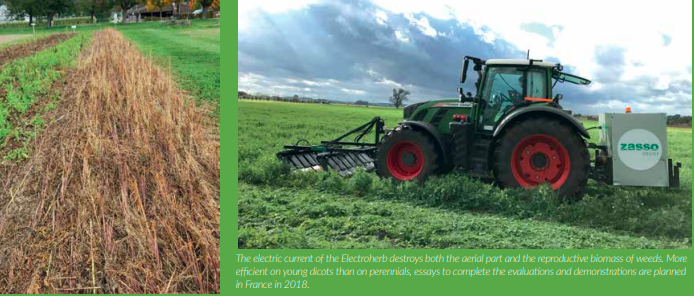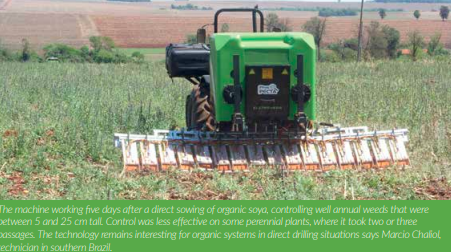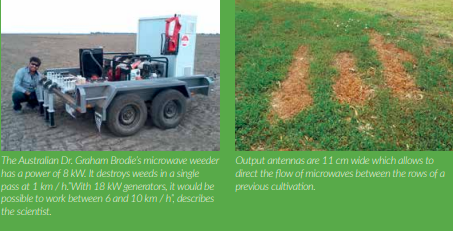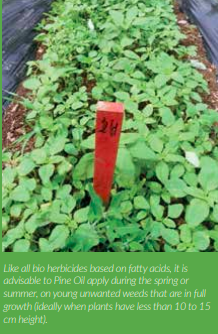Written by Maxime Barbier. First Published in TCS Magazine N°97 in March 2018
With the list of agrochemicals that is available to agriculture constantly shrinking and a threat hanging over the use of glyphosate, there is a growing interest more and more in alternative weeding solutions. All over the world many alternatives are being investigated; electricity, microwaves, thermal foam, water jet and bio herbicides. However a cheap and reliable alternative systemic weed killer at the same unbeatable price as glyphosate is not available currently. But who knows, from the emergence of all these innovations there will perhaps come new tools to help control the most challenging weeds growers and farmers face.
Will these alternatives consolidate or even improve our systems in both Conventional and Conservation Agriculture systems? The first problems appeared with the beginning of agriculture. Without the domestication of animals and crop raising we would probably have had to stay as hunter- gatherers, feeding on berries, acorns and wild meat. So busy finding food we wouldn’t be able to write this article! We evolved from largely a dense forest canopy of oak and beech to a succession of annual plants which has led to an incessant energy expenditure against Mother Nature who only wishes one thing; to return to a balance of perennials.
A struggle, helped in recent decades through the development of synthetic herbicides, has allowed us to maintain a perpetual crop of annuals. Now the list of usable agrochemical products as well as their efficiencies is decreasing, the situation is more and more urgent to find replacement techniques. Encouragingly, solutions exist already and interest is much revived and accelerated with the regulatory and consumer pressure on the use of glyphosate.

A complete herbicide through using an electrical current
The use of electricity as weed control technology was invented in the early 20th century but little interest was shown in the technique and had been largely forgotten due to the growth of synthetic herbicides after the Second World War. The first patents were issued in 1913, however it wasn’t until 1990 that the researcher NippoBresilien Satoru Narita, restarted the research on this method of weeding, with the help of private funds from a large owner of a forest that wanted to manage his weed problems which including herbicide resistance in some areas of the plantations he owned.
A project 10-year research was set up with the University of Brazil and in partnership with a Brazilian private sector company Sayyou, the first prototypes were launched in 2012. Large-scale trials of electrical current have been conducted in forestry and horticulture and also on wheat, soya, and citrus plantations. One major benefit is that the systemic action killing the whole plant. The current destroys both parts of the plant. The foliage and its root, preventing the plant from being able to regenerate.
“In the tests, the level of weed regrowth after 3 or 6 months is comparable to treated plots using glyphosate” says Benjamin Ergas, director of the company Zasso Group AG, from which Sayyou (now Zasso Brazil) is now part. Indeed, the machine, called the Electroherb, is distinguished by a destructive effect that kills foliage of the target plant to the root system. This mode of action is possible because the machine runs on a closed circuit. The PTO generator transfers the electricity to a row of “plant” applicators located on the front linkage made up of metal spatulas spaced every (10- 20 cm). Working widths are available from 1 to 10 meters. These applicators are interchangeable with a cultivator. As the spatulas touch the plants, the current flows through the tissues returning through a second row of spatulas which act as an earth closing the circuit. By getting into the vegetative parts of the plant, electricity has the action of breaking the vessels and damaging cells.

The machine delivers a high alternating current frequency (3-30 kHz), with a voltage (5,000-15,000 V), the charges usually don’t exceed 6000V. The dose of voltage is determined by field conditions and type of plants encountered. “The system self regulates according to many parameters: height and density of foliage and weed roots, soil moisture and density, topography, tractor speed and lastly width of Applicators. There are several patents that revolve around this problem, the main challenge being to provide a continuous and stable feed of current” explains the director. The energy needed varies from 100 to a 1,000 joules, enough to dry out foliage without burning or cooking it.
The destructive effect is better in full sun, although the manufacturer indicates that the machine can operate under most conditions, except heavy rain. There are less favorable conditions at dawn, because of the dew, and also when the plants to be destroyed are very close to the ground. In this case, the current may tend to dissipate more easily, the loss of effectiveness can then be order of 10% “ comments the specialist. The machine seems to have a useful action on dicotyledons, identified as having non-parallel leaf veins, tap roots and seedlings with two cotyledons. “The lower the dry matter of the plants, the more they are sensitive to the electrical current. This is equally the case for their root structure also.
Weeds with rhizomes like wild buckwheat are harder to destroy than grasses, which have a network of roots more which are more concentrated.” explains Matthias Eberius, technician at Zasso. New evaluations in 2018 were carried out in France. “We tried the prototype on organic plots of soybeans sown direct in the stubble of the previous crop. The technology is very interesting in organic systems as it may be possible to evolve towards a direct seeding approach. The operation was used just after sowing because we have a window of 5 days before crop emergence. The tool has controlled annual weeds, which measured between 5 and 25 cm above ground.
Control was less effective on some perennial plants, especially those well-established root systems, where it took two or three passages to achieve a kill. In our conditions, we must also be careful that the soil is not too wet so as to cause compaction because of the weight of the machine. In terms of diesel consumption, we’ve seen numbers between 10lt and 12 ltr / ha “, says Marcio Chaliol, from the Swiss company Gebana who supervises a group of organic producers “ABC” in southern Brazil. Since, the manufacturer worked on the machine weight, they have sold 15 machines in Brazil weighing on average 800 kg (200 kg for applicators and 600 kg for the generator). The aim is nevertheless for a significant weight reduction for future agricultural equipment.
The current working speed of Electroherb is around 3 to 5 km / h, although it is possible to go up to 10 km / h. The biggest constraint remains the contact time between the electrodes and the plant: it must be between 0.1 and 1 second dependant on the height of weeds present. With a current width of 2.5 m to 3 m wide, the machine has a work rate of 1 ha/hour. In terms of risks to soil fauna, worm tests of earth and springtails are in final stage of testing. At the moment, the final report is not available but according to the manufacturer, the impact is limited. “The results of tests carried out in 2017 under normal conditions and typical dose rates, did not show any significantly negative effects on earth worms, soil mites and microorganisms.
However tests carried out in non-targeted areas under normal use of equipment, such as wet permanent pasture, have revealed a sensitivity at very high doses, says the director. The scheduled tests for 2018 will seek to evaluate the dosage optimal for ensuring complete destruction of weeds while having minimal impact on non-target organisms. Is the magnetic field potentially harmful for the user? “Intensity of these fields was measured and the main source of radiation comes from the generator, which is shielded. The applicator’s radiation field that is produced is well below critical values for man and the environment” concluded Mr. Eberius. The price of the machine has yet to be announced by the manufacturer. They hope to launch the machine on the market in 2019.
By then, Arvalis and the French Institute of vine and wine will have finished conducting assessments on the safety of the machine. The current version will be available for demonstration in France in second half of the year.

Microwaves for “Cooking” weeds.
Another technology that has the advantage of not touching the soil is weeding by microwaves. Created initially in order to warm up frozen dishes, his interest in destroying unwanted plants has been studied since 1920. From pizzas to weeds, there is only one step. Graham Brodie, of the University of Melbourne in Australia, in 2006 used a kitchen microwave with a power of 600 watts to study its weeding potential. “Microwaves make the water molecules contained within the food stuff or plant to oscillate very fast.
Plant moisture is transformed into steam that generates a strong pressure that will degrade the cellular structure. It’s also very impressive to hear the vegetation cracking as the machine moves across the field”, says Graham Brodie. Since 2008, he has been developing an experimental version with a power of 8 kW. It consists of four independent generators of 2 kW each. The output antennas are 11 cm wide which allows the wave to be directed between rows where cultivation has taken place. “The tool is used at a speed of 1 km / h, which generates a temperature 60 ° C on the floor, enough to eliminate weeds at a young stage. With a power of18 kW, it would be possible to work between 6 and 10 km / h, and there are already generators of nearly 100 kW “, he says. The machine is also used to treat the soil in order to reduce the weed seed bank and will also destroy some organisms, pathogens such as nematodes, bacteria and fungi various fusarium and slerotium).
This operation however requires much more energy and operates at a much slower forward speed: 40-50 m / hour. The effect on weed development, on the other hand lasts for much longer. Of the tests carried out before sowing cereals (rice, wheat) it was showed that under certain conditions a weed pressure reduction up to 85% over to the untreated cultivated land. The tests have also shown gains in yields that varied between + 35% and + 92%. “Microwaves will only penetrate to 5 cm, but that is enough to kill some of the bacteria present.
Which is the same as a tillage operation but without the soil movement. This destruction also causes a mineralization effect and the release of nitrogen is where the yield increase comes from. Populations of bacteria regenerate very quickly and after a few weeks, there are more bacteria than before the passage of the machine. It was noted that this effect on the soil treatments performance persists even during the next three seasons, “added Graham Brodie.

Microwaves also have a positive effect on slugs.
In addition to weeds, the technology helps to control slugs and snails. Tests show, the energy required to kill them was ten times less than those needed to destroy the plants present (see table). The flip side or these kill rates also relates to their effect on earth worms and all other useful macro fauna that can be found on the soil surface. “At this point we don’t know the effect of this on this macro fauna. Microwaves will probably kill earth worms very close to the surface just as a tillage pass would.
Those at depth are protected because the effect is not going below 5 cm”. The other major drawback of this technology is energy consumption. The 8kW machine needs two electricity generators of 7 kW. There is therefore a loss of energy inherent in the process of running the machine that emerges as heat lost to the atmosphere and which is not recovered. “The efficiency of a household microwave is less than 50% whereas in the agricultural system current is around 75-80%. But industrial generators in closed systems ensure efficiencies of 90%, concludes Graham Brodie.
Further green chemistry
In addition to these mechanical technologies, another solution to consider is bio herbicides. These are obtained from natural active molecules found in living organisms: bacteria, fungi, and plants. A quick overview of available solutions brings one particular product to the top of the search. Marketed by the company Jade, this is a product which has gained approval for field crops in France. Belukha is non-selective herbicide consisting of pelargonic acids (nonanoic acid), an acid fat obtained after during the extraction process for rapeseed oil.
These molecules act by contact dehydrating the cells of the plant, causing it to dry out. Belukha is a non-systemic product. In 2018 it was approved for use on vines, fruit trees and for desiccation of soil beneath the apple trees. Like all products of this type, it is advisable to apply in the spring or summer, on weeds in full growth. Its efficiency for certain weeds is know if used in good conditions and must be accompanied by crimping. “In our tests, when crimping and defoliating have been made in sunny weather it has increased the efficiency by 20% when used at the recommended dose (16 l / ha). The main problem to this approach is the cost per hectare. A price that is, hopefully, likely to decrease over time.

A Bio herbicide with potential – But at a Price
Another solution is pine oil extract. Marketed in New Zealand and Australia for several years, it is produced in Quebec by AEF Global. Efficiency has been increased by raising the purity of the refined oil. The product has been shown to achieve up to 100% control on some broadleaf weeds and also on some annual grasses. Used at a dilution rate of 10% (on plants at the cotyledon stage) at 20% (on plants over 5 leaves) without addition of adjuvant. Here again the problem lies in the cost which is around 600 € / ha. The product can however find its place in agriculture when used for spot treatment with a jet directed in the row of maize combined with hoeing inter row hoeing. “It can be used in cereals from the five leaf stage of the crop” says Claude Dubois, director of the company, which will launch the product in 2019 in the Canadian market.

In the United States there is another bio herbicide based on fatty acid which interests the organic market. Marketed by the company Westbridge under the name of Suppress, it’s a mixture of caprylic acid and the acid caprique, two fatty acids that it is possible to extract from Goat cheese! On sale for four years it’s been used on several thousand hectares and claimed to be effective on dicotyledons and also on grasses, even in cold conditions. Applied at a dilution rate that varies from 3 to 9% (on average 6% for an application rate of 230lt/ha of water) depending on level of the plants development.
The product is used mainly on fruit trees and vines, taking care not to touch the foliage of crops with a cost of 250 €/ ha. It also has some use in cereals as a pre-harvest biological desiccant but remains a very expensive approach. It is also used on soybeans as an interrow herbicide, with directed applicators which protect the soya foliage. In Argentina it is used in soybean oil production by organic farmers who are trying direct drilling. The key to the products effectiveness is the lecithin contained within the legume that causes a drying effect. Lecithins are complex molecules, phospholipids, consisting in part of fatty acids. “It’s necessary to choose varieties rich in lecithin, while the dilution rate for this is 5%”. Attempts have been made to use it when direct drilling soya into a crimped crop of cereal rye.
A first application is made during the first pass when rolling the rye to create a mulch. While the second application is made after drilling. The product has a residual effect which lasts for ten days allowing the soya time to establish. The oil is not easy to use because it’s hard to mix in the tank of the sprayer and requires constant agitation. Levels of control are in the order of 66% on young seedlings at the 1 to 2 leaf stage, which is very useful for organic farmers. According to producers, sunflower oil could also be used, provided that the varieties are lecithin-rich.

Further products in the pipeline
Finally, another bio herbicide who might have a use for permanent cover crop situations, is a product is called Organo-ground. It consists of a lactic acid bacteria mixture of the Lactobacillus family, which comes from the fermentation of dairy products which produce citric acid and lactic. This product provides partial control of some legumes like white clover or bird’s-foot. Authorized by the Canadian Government, it is currently only available for domestic use under the name of Bioprotec herbicide and the cost is still too high for use on broad acre crops.
“The substance is attractive enough for use in amenity situations but because of the regulatory context in place, this is also limiting its use as a conventional herbicide. Due to its limited selectivity and its cost it never been marketed widely “ says Claude Dubois, from the company AEF global. He concluded it must be made clear that the development of products based on microorganisms is much easier outside the EU due to the less restrictive regulations. In France, INRA work a lot with the development and potential long term impact of this type product as the effects can take many years to become apparent. Because of this they will take longer to bring to market and therefore be more expensive. This is just a taste of some of the current developments in the bio herbicides arena one thing is certain is that they are likely to be less effective than current synthetic weed killers.